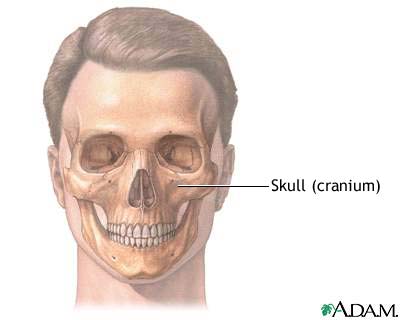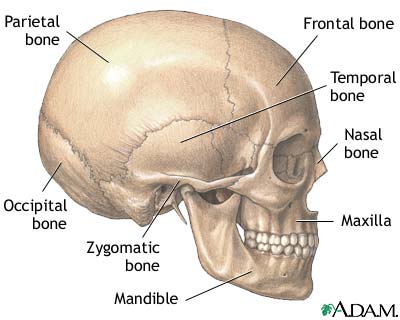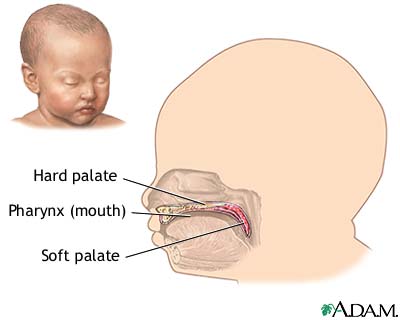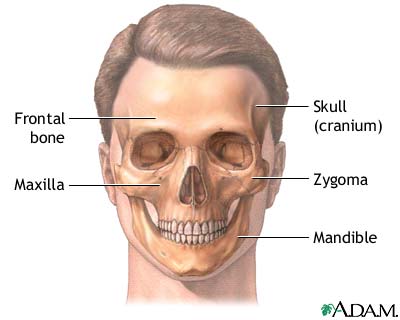Head and Face Reconstruction
Skull

The skull is anterior to the spinal column and is the bony structure that encases the brain. Its purpose is to protect the brain and allow attachments for the facial muscles. The two regions of the skull are the cranial and facial region. The cranial portion is the part of the skull that directly houses the brain and the facial portion includes the rest of the bones of the skull.

The skull is the bony structure of the head and face. The cranium surrounds the brain with the temporal, frontal, parietal and occipital bones. The maxilla, or upper jaw, and the mandible, or lower jaw, support the facial features of nose, mouth and eyes.
Cleft lip repair - series: Normal anatomy
 |
Craniofacial reconstruction - series: Normal anatomy
 |
Definition
Surgical treatment to repair deformities of the head and face (craniofacial).
DescriptionSurgery for head and face deformities (craniofacial reconstruction) depends on the type and severity of deformity, and the condition of the patient.
In some cases, because surgical repairs involve the skull (cranium), brain, nerves, eyes, facial bones, and facial skin, a plastic surgeon (for skin and face) and a neurosurgeon (brain and nerves) work together. Head and neck surgeons may also perform craniofacial reconstruction operations.
The surgery is done while the patient is deep asleep and pain-free (under general anesthesia), and may take from 4 to over 12 hours to complete. Some of the facial bones are cut and repositioned into a more normal facial structure.
Pieces of bone (bone grafts) may be taken from the pelvis, ribs, or skull to fill in the spaces where bones of the face and head have been moved. Small metal screws and plates may be used to hold the bones in place. The jaws may be wired together to hold the new bone positions in place.
If the surgery is expected to cause much swelling of the face, mouth, or neck, the airway can become blocked. If this is anticipated, the patient may have what is called a tracheotomy placed, in which a small hole is made in the neck through which a tube (endotracheal tube) is placed in the airway (trachea).
This allows the patient to breath despite severe swelling of the face and upper airway that occurs after some operations and may persist for weeks.
IndicationsGuidelines for craniofacial reconstruction include:
- birth defects (such as hypertelorism, Crouzon's disease, Apert's syndrome)
- injuries to the head, face, or jaws (maxillofacial)
- tumors
- deformities caused by treatments of tumors
Risks for any anesthesia are:
- reactions to medications
- problems breathing
Risks for any surgery are:
- bleeding
- infection
Additional risks of surgery of the head and face are:
- nerve damage (cranial nerve dysfunction)
- permanent scarring
- partial or total loss of bone grafts
- need for follow-up surgery
No comments:
Post a Comment